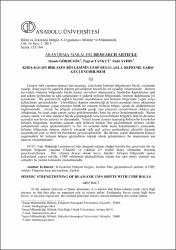Kiriş-Kolon Birleşim Bölgesinin Cfrp Rulolarla Depreme Karşı Güçlendirilmesi
Abstract
Çerçeve türü yapıların deprem davranışında: kiriş-kolon birleşim bölgelerinin büyük zorlamalar taşıdığı, dolayısıyla bu yapıların deprem güvenliğinde önemli bir rol oynadığı bilinmektedir. Deprem kuvvetleri, birleşim bölgesinde büyük kesme kuvvetleri oluşturmakta, bunlardan kaynaklanan eğik
asal çekme gerilmeleri de eğik çatlamalara ve giderek birleşim bölgesindeki betonun dağılmasına yol açmaktadır. Bu gerilmelerin sağlıklı biçimde taşınabilmesi için birleşim bölgesinde yoğun etriye kullanılması gerekmektedir. Yürürlükteki deprem yönetmeliği de kolon ucundaki etriye sıklaştırma
bölgesinde kullanılan yoğun etriyenin belirli bir oranının birleşim bölgesi içinde de sürdürülmesini öngörmektedir. Ancak, bu bölgede yönetmelik gereği olan etriyenin yerleştirilmesi oldukça güç olduğundan, bu koşul çoğu zaman yerine getirilememekte, hatta hiç etriye konulmamaktadır. Bunun sonucu olarak, var olan yapıların büyük çoğunluğunda kiriş-kolon birleşim bölgeleri deprem davranışı açısından son derece yetersiz bir durumdadır. Yeterli kesme donatısı taşımadığı bilinen bir kiriş-kolon birleşim bölgesinde, dışarıdan açılacak eğik deliklere karbon fiber güçlendirmeli polimer ruloları yerleştirilerek oraya epoksilenmeleri ve her iki ucundan delik dışına kenetlenmeleri sonucunda, birleşim bölgesinde deprem etkisiyle oluşacak eğik asal çekme gerilmelerini güvenilir biçimde taşıyabilecek yeni ve etkili bir düzenleme gerçekleştirilebilir. Bu ilkenin, çeşitli durumlarda kolayca uygulanabilir bir birleşim bölgesi güçlendirme tekniği olarak geliştirilmesi, bu araştırmanın ana amacını oluşturmaktadır.
ODTÜ Yapı Mekaniği Laboratuvarı’nda deneysel çalışma olağan boyutlu bir çerçevenin bir dış birleşim bölgesini yansıtan T-biçimli ve yaklaşık 2/3 ölçekli deney elemanları üzerinde gerçekleştirilmiştir. Biri referans deneyi olmak üzere; diğerleri birleşim bölgesinde epoksi kullanılarak çapraz şekilde, CFRP rulolarıyla güçlendirilmiş toplam beş adet deney elemanı test sonuçları bu yazının konusunu oluşturmaktadır. In the seismic behavior of frame structures, it is known that beam-column joints carry high stresses, so that they play an important role in seismic safety. Earthquake forces create high shear forces in the joint region and the inclined principal tensile stresses formed by this action induce diagonal cracks, which eventually lead to disintegration of concrete. To resist these stresses, use of ties is needed in the joint region. The seismic codes in effect require continuation of a certain ratio of closely spaced ties used in the region at the column ends, in the joint region. Since the placement of ties required by the code in this region is rather difficult, this condition is hardly fulfilled and in some cases even no ties are placed in the joint at all. As a result of this, in the majority of existing structures, beam-column joints are in a very deficient State in terms of their seismic behavior. In the case of a beam-column joint, where it is known that there are not sufficient shear reinforcement, it is thought that new reinforcement, which can carry inclined principal tensile stresses developing in the joint due to earthquake forces, are provided by placing carbon fiber reinforced polymer rolls into the inclined holes drilled from the outside and by gluing them there using epoxy and by anchoring the ends from the outside. This research mainly aims to develop a practical joint strengthening technique on this principle. The experimental study was carried out at the METU Structural Mechanics Laboratory and using T-shaped test specimens reflecting an exterior joint region of a frame having normal dimensions, to a scale of 2/3. Test results of five specimens, one reference and four strengthened with diagonal CFRP rolls are reported in the present paper.
Source
Anadolu Üniversitesi Bilim ve Teknoloji Dergisi A - Uygulamalı Bilimler ve MühendislikCollections
- Cilt.14 Sayı.2 [8]


















